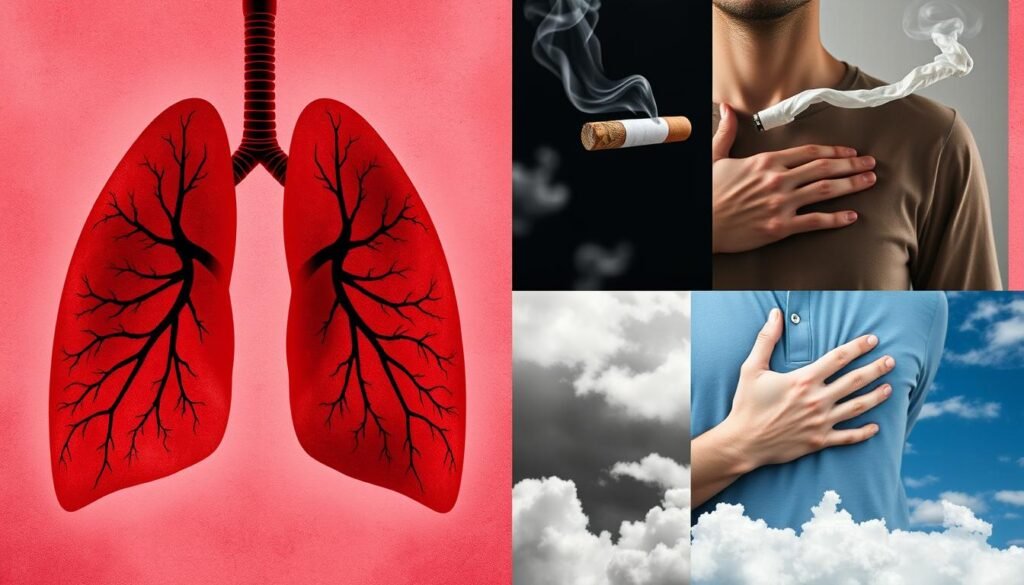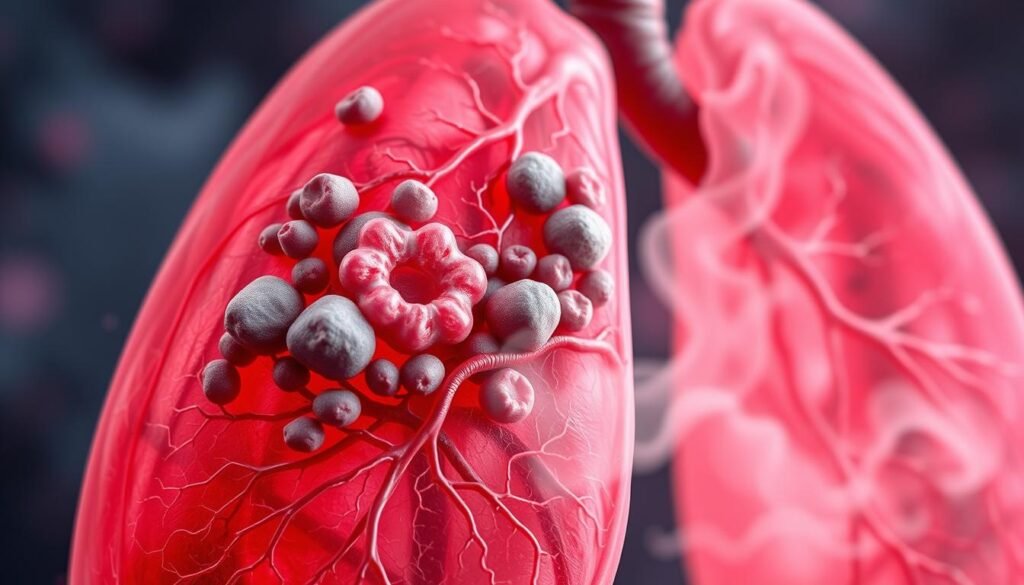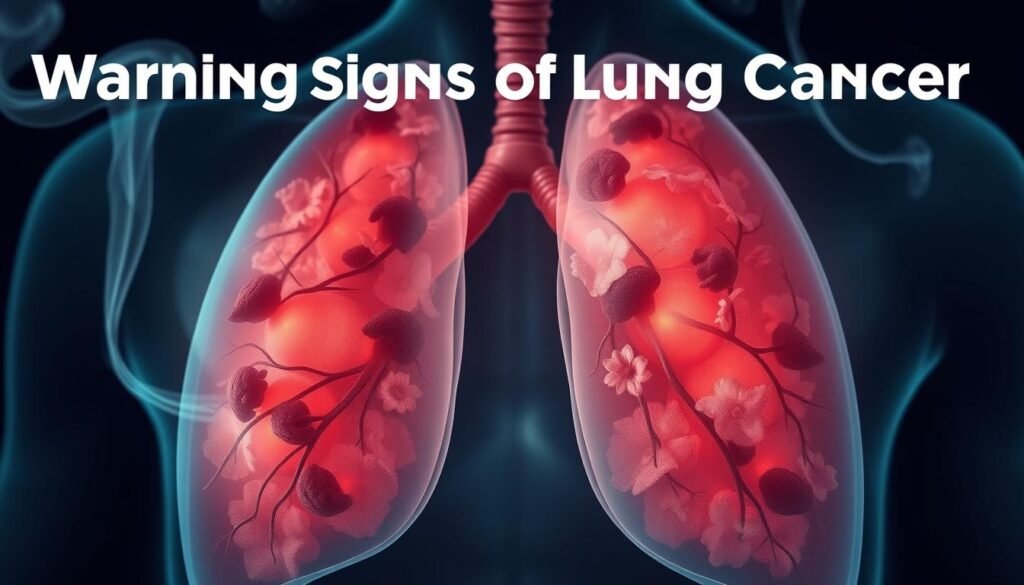Did you know that over 70% of people with lung cancer show no symptoms early on? This fact shows how important it is to know the symptoms of lung cancer. Catching the disease early can make a big difference in treatment success. Knowing the early signs is crucial.
Lung cancer is the top cause of cancer deaths worldwide. It’s key to know the early symptoms. Symptoms like ongoing coughing, chest pain, and losing weight without trying can warn us. By spotting these early, you can get help sooner and improve your chances of beating it.
Key Takeaways
- Most lung cancers do not cause symptoms until they have advanced.
- Early diagnosis can lead to more effective treatment options.
- Common symptoms include coughing, chest pain, and weight loss.
- Some symptoms may indicate metastasis of lung cancer.
- Understanding these signs can prompt timely medical consultation.
Introduction to Lung Cancer
Lung cancer is a major health issue worldwide. It leads in causing cancer-related deaths, affecting many lives. It originates when lung cells change due to certain factors.
About 85% of lung cancer cases are from smoking. Secondhand smoke, radon gas, and harmful materials are also risks. Mostly, it’s found in adults over 60.
There are two main lung cancer types: non-small cell (NSCLC) and small cell (SCLC). NSCLC makes up 85% of cases, while SCLC is about 15%.
Knowing these types helps recognize symptoms and treatment options. Early detection is key. It leads to better diagnostics and treatments. Tests like CT scans and sputum exams are crucial.
Lung Cancer Symptoms Overview
Lung cancer leads in causing deaths from cancer in men and women. Many people don’t notice the lung cancer symptoms until it’s too late. This makes lung cancer diagnosis harder. The symptoms often look like those of other sicknesses. Knowing the common symptoms of lung cancer is key for getting help early.
A few main symptoms are constant coughing, pain in the chest, and feeling short of breath. A cough that won’t stop might mean a serious issue. Chest pain that comes without a clear reason is a red flag. Feeling short of breath along with these can make breathing tough.
Spotting lung cancer early is often hard. Many don’t feel sick at the beginning. Yet, most find out they have it when it’s already in a late stage. Waiting too long to get diagnosed can lead to worse outcomes. That’s why it’s crucial to know the early signs of lung cancer.
It’s important to spread the word about these signs. This can help catch the disease early. Knowing what symptoms to look for can start timely talks with doctors. It leads to better tests and treatments.
Early Signs of Lung Cancer
Knowing the early signs of lung cancer is crucial. A persistent cough is often the first clue. Over time, this cough may get worse, signaling a serious problem.
Coughing That Doesn’t Go Away
A cough that lasts over eight weeks may suggest lung cancer. It’s different from a common cough and might include coughing up blood. If this happens, it’s important to see a doctor right away.
Shortness of Breath
Shortness of breath is a frequent early sign. It can occur when the airways are blocked or lung capacity decreases. This makes even simple tasks tougher.
Chest Pain
Chest pain in lung cancer patients can feel different. It may be a dull ache or sharp pain. Activities or deep breaths can make it worse. Early detection of this pain helps in getting timely treatment.
Common Lung Cancer Symptoms to Recognize
Knowing the signs of lung cancer is critical for early detection and treatment. Many symptoms might not be noticed until the disease is advanced. Spotting signs like coughing up blood, breath changes, and losing weight early can save lives.
Coughing Up Blood
Coughing up blood is a serious warning sign. It may look like bright red blood or rust-colored spit. This calls for urgent medical care, as it could mean tumors or serious lung issues.
Wheezing and Hoarseness
Wheezing and a rough voice can mean blocked airways or a tumor affecting breathing. If you wheeze a lot, especially with other symptoms like constant coughing, get checked. A hoarse voice lasting more than two weeks should also be examined by a doctor.
Loss of Appetite and Unexplained Weight Loss
Sudden appetite changes and losing a lot of weight might be lung cancer reacting in the body. These signs shouldn’t be ignored because they could show serious health problems. For more details on these symptoms, you can read about unexpected lung cancer signs.

Lung Cancer Early Symptoms: What to Look For
Identifying early lung cancer symptoms is key for quick treatment. Some people may not see clear signs until the cancer is advanced. Yet, there are early signs that need your attention.
Feeling Tired or Weak
Feeling tired can be an early sign of lung cancer. While we often think tiredness is normal, it might be more serious. If tiredness doesn’t go away and comes with other symptoms, it’s time to see a doctor.
Recurrent Infections
Watching for repeated lung infections is important. Problems like bronchitis and pneumonia that don’t go away could be warning signs. These frequent or hard-to-treat infections could mean lung cancer. This knowledge should encourage people to get checked by a doctor. Learn more about early signs here.
Metastatic Lung Cancer Symptoms
Metastatic lung cancer symptoms depend on where in the body the cancer spreads. It’s very important to know these signs for early treatment. If cancer reaches the bones, bone pain might start. Changes in the nervous system can show if the cancer has spread to the brain. Also, swollen lymph nodes in the neck or above the collarbone often mean the cancer has spread.
Bone Pain and Nervous System Changes
Bone pain is a key sign for those with metastatic lung cancer. If cancer moves to the bones, it can cause ongoing pain or discomfort that gets worse. This makes daily life harder and can lower life quality. If the cancer spreads to the brain, it might lead to nervous system changes. Symptoms can include being confused, feeling sleepy, or having trouble moving. These signs show the cancer has moved past the lungs.
Swelling of Lymph Nodes
When metastatic lung cancer spreads to lymph nodes, they can swell. Often, this causes visible lumps in the neck and armpits. These signs are warnings of the cancer’s spread and underscore the importance of regular checks. Catching these signs early helps in managing the cancer effectively.

| Symptom | Description |
|---|---|
| Bone Pain | Persistent pain resulting from cancer’s spread to the bones, affecting mobility and daily activities. |
| Nervous System Changes | Symptoms like confusion or drowsiness, indicating cancer’s impact on brain function. |
| Swollen Lymph Nodes | Lumps in areas such as the neck or armpits, suggesting potential metastasis to lymphatic systems. |
Pancoast Tumors and Their Symptoms
Pancoast tumors are a rare type of lung cancer, making up 3 to 5% of all cases. They are found at the top of the lungs. These tumors cause unique symptoms that need quick and careful evaluation.
Horner Syndrome
One key sign of Pancoast tumors is Horner syndrome. This affects the eyes and face, leading to:
- Drooping of the eyelid
- Pupil constriction
Up to 40% of people with Pancoast tumors show these symptoms. They serve as an important warning sign for doctors.
Superior Vena Cava Syndrome
Pancoast tumors can lead to another condition called superior vena cava syndrome. This happens when a major vein is compressed, causing:
- Swelling of the face and neck
- Difficulty breathing
- Visible veins in the neck and chest
This syndrome signals the tumor’s severe impact, urging for quick medical action.
Understanding Lung Cancer Warning Signs
Knowing the signs of lung cancer is key for early treatment. Many symptoms might seem minor, like those of common illnesses. It’s vital to notice lasting health changes as they might signal lung cancer.
Often, lung cancer gets found late. This underlines the need for better early detection. People with a type called non-small cell lung cancer see symptoms come on slowly. Not catching these early can limit treatment choices and affect outcomes.
Small cell lung cancer behaves similarly. Its symptoms get worse as it progresses, complicating early discovery. Sometimes, certain conditions like SIADH or Cushing syndrome can hint at lung cancer before clear lung symptoms show.
Experts at places like City of Hope’s Lung Cancer Centers use a team approach. This method, involving various specialists, aims at spotting lung cancer signs sooner. Their joint work can lead to better results and treatments.
Noticeably losing weight—ten pounds or more without trying—should raise concern. Such symptoms, among others, need checking out right away. Getting regular checks helps, as lung cancer might not show clear signs early.

Being aware of these signs is crucial. If you see persistent health changes, talk to a doctor. Spotting and acting on lung cancer signs early on can enhance care and health management.
| Warning Signs | Description |
|---|---|
| Coughing that doesn’t go away | A persistent cough may indicate underlying lung issues. |
| Shortness of breath | Difficulty in breathing can be a major red flag. |
| Chest pain | Pain in the chest area may signify serious conditions. |
| Wheezing or hoarseness | Changes in voice or breathing can be concerning. |
| Unexplained weight loss | Unexpected weight loss can often be an alarming symptom. |
Paraneoplastic Syndromes Related to Lung Cancer
Some lung cancers cause paraneoplastic syndromes. These are not from the tumor itself, but from the body’s reactions. Recognizing them helps catch cancer early, which is key for treatment. For example, changes in hormones and nervous system symptoms tell doctors about possible cancer.
Endocrine and Neurologic Symptoms
Lung cancer can bring about endocrine symptoms. These include Cushing’s syndrome or SIADH. Many lung cancer patients, about half, might have too much ACTH. This leads to Cushing’s syndrome with effects like weight gain and high blood pressure.
Neurologic issues, such as Lambert-Eaton myasthenic syndrome (LEMS), are also seen. Around 60% of patients with small-cell lung cancer (SCLC) might have LEMS. Yet, it’s often missed. Symptoms include weak muscles, tiredness, and sexual problems in men. Finding certain antibodies helps diagnose these syndromes linked to lung cancer.
| Paraneoplastic Syndrome | Associated Symptoms | Percentage in Lung Cancer Patients |
|---|---|---|
| Cushing’s Syndrome | Weight gain, hypertension | Up to 50% |
| Syndrome of Inappropriate ADH Secretion (SIADH) | Hyponatremia, fluid retention | Common |
| Hypercalcemia | Neurologic effects, psychiatric manifestations | 2%-6% at diagnosis, up to 12% during the disease course |
| Lambert-Eaton Myasthenic Syndrome (LEMS) | Muscle weakness, fatigue | 60% in SCLC patients |
It’s crucial for both doctors and patients to know about these syndromes. They can signal lung cancer early on. This knowledge helps with quick action and better patient care. Early symptom recognition can greatly improve outcomes.
Diagnosing Lung Cancer: The Role of Symptoms
Correctly diagnosing lung cancer is critical for effective treatment. It largely depends on recognizing symptoms of lung cancer. Symptoms can include a persistent cough, chest pain, or trouble breathing. These signs often don’t appear until the disease is advanced, making early detection hard.
It’s crucial to see a doctor quickly if you have these symptoms. Doctors will check your medical history and do a physical exam. They also use imaging tests like CT scans, PET scans, and chest X-rays to look at your lungs. CT scans are especially good at finding lung tumors, better than regular X-rays.
Tests like needle biopsies and sputum cytology help confirm if cancer is present. For certain cases, bronchoscopy and thoracoscopy can spot blockages or test suspicious areas. People over 50 or those who have smoked a lot should get screened with low-dose CT scans. This includes current smokers or those who quit in the last 15 years.
Knowing the symptoms of lung cancer and the importance of catching it early can save lives. Conditions like COPD have similar symptoms, making diagnosis challenging. It’s important to tell these symptoms apart for a correct diagnosis. Regular check-ups and looking after your lung health are key steps to staying healthy.
For more info on lung cancer signs and what to watch for, check out this useful resource.
Being aware of lung cancer symptoms and acting on them is the first step in diagnosing. This leads to better chances for successful treatment.
Lung Cancer Treatment Options Based on Symptoms
Treatment for lung cancer varies based on the cancer’s type and stage. It also depends on lung function and overall health. In advanced stages, treatments aim to manage symptoms rather than cure.
For non-small cell lung cancer (NSCLC), treatment options differ. Early stages might undergo surgery. Advanced stages could need chemotherapy, radiation, immunotherapy, and targeted therapies. Small cell lung cancer (SCLC) usually gets chemotherapy and radiation. This is for limited disease. For extensive disease, treatments focus on comfort and quality of life.
Quitting smoking before treatment can make it more effective. It also reduces side effects. Starting healthy habits like diet and exercise helps manage symptoms and recovery.
Removing lymph nodes during surgery is crucial. It shows if cancer has spread. Techniques like video-assisted thoracoscopic surgery (VATS) help patients recover faster.
Radiation therapy is key in killing cancer cells. It can be used with surgery and chemotherapy. Palliative radiation eases symptoms like pain and breathlessness, helping comfort. For early NSCLC, surgery can cure. Other stages might need a mix of treatments to improve life quality.
Importance of Early Detection of Lung Cancer Symptoms
Finding lung cancer early is key to better treatment results. Only 21% of lung cancers are caught early, at stage I. Early-stage patients have a much better chance of surviving more than five years after finding out they’re sick.
Screening tests like LDCT scans are good for those at high risk, like smokers. The American Cancer Society suggests yearly LDCT for those 50 to 80 with a heavy smoking past. Catching cancer early with these scans can save lives.
The Centers for Medicare & Medicaid Services (CMS) help pay for screenings for some, based on age and if they smoked a lot. If you’re not covered by these rules, talking to a doctor about other ways to get screened is smart.
Even though LDCT scans use a bit of radiation, they’re better at saving lives than regular chest x-rays. Chest x-rays don’t do much to help lung cancer patients live longer. But, the advantage of finding cancer early with LDCT scans is much bigger than the small risk from radiation.
Lung cancer is the second most found cancer and the top cancer killer in the U.S. Knowing the signs and getting diagnosed early can lead to faster treatment, improving the odds. Not smoking drastically cuts the risk of lung cancer. This highlights why it’s essential to prevent it, especially for those at high risk.
Watching for symptoms and getting screened on time greatly helps in fighting lung cancer. It shows why we must keep teaching those at risk about it.
For more details on early detection and screening choices, read this detection resource.
Conclusion
Lung cancer awareness is crucial in today’s world. Around 85% of cases are tied to smoking. Spotting symptoms early can greatly change outcomes. It’s vital to know, lung cancer affects 1 in 15 men and 1 in 17 women during their lives.
This fact underlines the importance of knowing symptoms and taking charge of our health. People should keep an eye on their health and talk to doctors about any strange or persistent signs.
Getting medical advice early can catch lung cancer soon and open up many treatment options. Options include surgery, chemotherapy, and targeted treatments. Knowing your choices helps you take an active part in your treatment.
Regular check-ups and talking freely with your doctor about any symptoms can help find lung cancer early. This is crucial because early-stage lung cancer is more treatable.
Knowledge about lung cancer’s signs and risk factors leads to better health actions. By learning more and staying alert, we can greatly improve our chances of good health. Remember, catching it early can truly save lives.